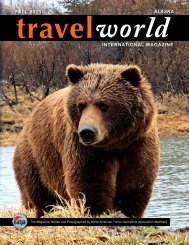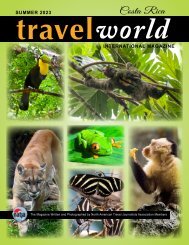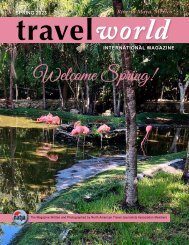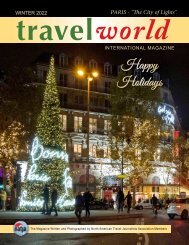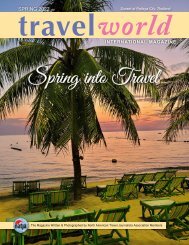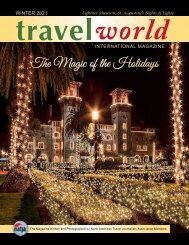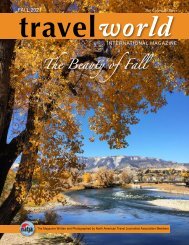TravelWorld International Magazine Fall 2022
The magazine written and photographed by North American Travel Journalists Association members.
The magazine written and photographed by North American Travel Journalists Association members.
Create successful ePaper yourself
Turn your PDF publications into a flip-book with our unique Google optimized e-Paper software.
MONTEREY BAY<br />
f Monterey Bay had a mascot, it would<br />
be the sea otter. These marine<br />
mammals provide endless hours<br />
of entertainment to the visitors<br />
of the Monterey Bay National<br />
Marine Sanctuary in Central<br />
California. Often they can be<br />
seen in the giant kelp forest<br />
close to the water’s edge where<br />
they search for food.<br />
A sea otter in the Monterey Bay<br />
National Marine Sanctuary--photo<br />
provided with permission by NOAA<br />
Among the largest protected ocean<br />
areas in the United States, the Monterey<br />
sanctuary is larger than Yellowstone<br />
National Park. This vast area is home to 36<br />
species of marine mammals including sea otters,<br />
dolphins, porpoises, and blue whales. In addition there<br />
are 525 species of fish and 180 types of sea and shore birds.<br />
With the summer season attracting large crowds to the Monterey Peninsula, fall is ideal for a quieter experience. And like<br />
Channel Islands, this is the perfect time to watch migrating blue whales.<br />
A highlight of any visit to Monterey Bay sanctuary is a kayak ride through the kelp forest. Sea otters are often seen floating<br />
in rafts (groups of resting sea otters) and searching for food. The occasional harbor seal can be seen bobbing up and down<br />
as well. Rent a kayak for a self-guided experience or take an organized tour with Adventures By The Sea.<br />
HAWAIIAN ISLANDS<br />
HUMPBACK WHALES<br />
Humpback whale in the Hawaiian Islands Humpback National<br />
Marine Sanctuary--photo provided with permission by NOAA<br />
tarting in November and<br />
continuing through April,<br />
thousands of humpback<br />
whales travel to the warm,<br />
shallow waters of Hawai to<br />
mate, give birth, and raise<br />
their young. In fact half the<br />
population of the North Pacific<br />
humpback whales use these<br />
waters seasonally. Hawaiian Islands Humpback<br />
Whale National Marine Sanctuary protects<br />
these whales and their habitat. While it is<br />
possible to view the whales from land, many<br />
visitors opt to join an organized whale watching<br />
tour to see them up close.<br />
To learn more about these magnificent creatures–along with all the other marine life–check out the Visitor Center in<br />
Kīhei Maui. In front of the center is the native Hawaiian fishpond called Kōʻieʻie. The three-acre pond is one of the last<br />
remaining intact traditional fish ponds along the south Maui coastline.<br />
58<br />
Other activities in the sanctuary include snorkeling, diving, surfing, paddle boarding, and recreational fishing.






